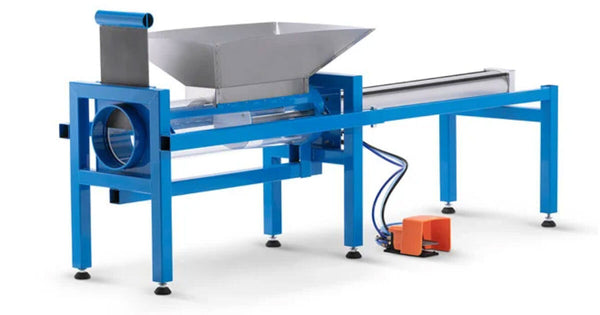BHO Tools 101: Professional Tools for BHO Extraction
Jun 22, 2021
Light hydrocarbon extraction, also known as butane hash oil or butane honey oil (BHO) extraction, is the industry standard for producing high-grade cannabis concentrates. From distillates to live resin, hydrocarbons as solvents offer better versatility and efficiency compared to other extraction methods.
Choosing the right equipment for your extraction operations affects the quality and throughput you will get from your runs. For BHO extractors that want to take their operations off the ground or to the next level, these BHO extraction equipment essentials can help produce a pure and potent BHO concentrates at scale.
How to Craft Connoisseur-Grade Butane Hash Oil

Commercial extractors know all too well the importance of working in a compliant, lab-grade environment with closed-loop systems. Since butane and propane are highly flammable, safety must be top of mind through every step of the BHO extraction process.
During hydrocarbon extraction, closed-loop systems pump liquefied and pressurized butane and/or propane through a column of packed cannabis biomass material.
As it passes through the biomass, the butane solvent separates the plant’s active cannabinoids (THC, CBD, etc) and terpenes. In the system, the solvent is evaporated, leaving behind a relatively solvent-free cannabis extract.
We have come a long way from the open blasting method that uses an open-ended tube in high-risk environments. Now, cannabis processors can use engineer-approved hardware that nearly eliminates the risk for explosions, unlike the dangerous open blasting process.
Beyond the safety aspect, having the right hardware for making BHO ensures every run produces high-quality oil in the long run. Every component of the system must be of the highest-quality or else you risk affecting the entire process.
Solvents: Propane and Butane Gas
Sourcing high-purity solvents is one of the most important factors when creating BHO concentrates. Depending on your preference and experience level, you will choose the type and grade of the solvent, usually 100% N-butane, or 95% or higher.
The amount of butane you need depends on the amount of material you plan to extract and your storage limits. Solvent to biomass ratio also depends on how the biomass is packed. Is the material packed loose or compact? The structure of your packed column affects the efficacy of your solvent.
Butane and propane are odorless and colorless. Butane has a boiling point of 30.2º F, while propane’s boiling point is -43.6º F allowing you to use low temperatures.
Some BHO extraction technicians use a butane/propane blend (70%/30%) or other solvent blend ratios. With butane/propane blends or only using propane as a solvent, you will need to account for higher pressures.
Biomass Grinder
For the most efficient BHO runs, cannabis should be finely milled in preparation for extraction. The biomass must be milled to make a ground and homogeneous material. Industrial cannabis plant grinders can easily and quickly shred plant material into small particles.
Industrial-sized grinders have a large grinding chamber that can process high volumes of biomass for faster runs. Specialized grinders consider the thermal damage caused by high blade speeds.
Whether you are working with frozen buds during a nug run or dry trim and leaves, a biomass grinder can handle it all.
Biomass Packer

In the BHO extraction game, speed is everything. A biomass packer can streamline one of the most time-consuming and laborious parts of the BHO workflow. A packer can pre-pack cannabis biomass quickly and evenly. No guesswork here.
Some biomass packers are easy to use. Simply add the loose biomass and use a foot switch to pack your material. You can adjust the pressure to get your desired packing level.
Avoid using excess time and labor that you could be dedicating toward something with a greater ROI. No longer will you need heavy rods to pack your biomass. A biomass packer uses thousands of pounds of force to make an even and consistent pack.
Creating a consistent pack and following tried-and-true SOPs can create a consistent and reliable BHO product. Using a packer, you can pack your biomass up to 60% effectively compared to packing manually.
In addition, pre-packing your biomass saves you on storage space. Packing biomass can reduce volume by up to 85%.
Closed-Loop Extraction Equipment

In the open-blasting method, the butane gas can become dangerous, especially in the presence of a spark. Open blasting is one of the most dangerous extraction methods. Closed-loop extraction creates a contained environment where operators can use butane and propane.
Closed loop BHO extractors vary in price, size, and functionality, but all can create a solvent-free BHO product. Ideally, processors would start with a simple system to learn the ropes and scale up naturally. A 1 lb. top fill, tabletop unit is a good starting off point for personal or sample-size extractions with fast throughput.
Gradually, you can graduate onto active rack systems that can handle several pounds at a time. More commercial-grade and automated systems can handle dozens of pounds of material for high-volume BHO production.
In the closed-loop extraction process, the plant material is packed into the material column. The butane is chilled to cold temperatures in a solvent column and pumped over a packed material column. The solvent separates the cannabinoids and terpenes from the plant to produce BHO crude oil.
In the collection tank, the solvent and BHO extracts are heated in order for the butane to evaporate. A gas compressor pulls out the evaporated butane from the recovery column. The solvent goes through the condensing column, which cools the butane gas into a liquid form again.
When selecting your BHO extractor, consider the capacity you are extracting. Can the extraction equipment handle the volume of production?
Generally, BHO columns are made of carbon or stainless steel. We recommend going with the industry standard: stainless steel. Stainless steel can help keep the solvent cleaner and will not rust with time and use.
Hoses
Hoses are an integral part of a closed loop system. Hoses can function as plumbing for your closed loop system or connect other equipment such as heaters and chillers to a short path distillation unit.
Go for durable and anti-static hoses in the extraction room rated for very low and high temperatures. Hoses range in size from just a few inches to several feet long.
Gaskets
Standard gaskets are a necessity to create an airtight seal for different components and connections in the system.
For instance, mesh gaskets can go at the bottom of a column that holds the biomass or filter media. Mesh gaskets are an excellent tool for filtration for chromatography and can be used to eliminate certain particulates. Gaskets are available in a range of sizes from 1.5 in to 6 in.
Fittings
NPT fittings may be the smallest components in your equipment, but they require the highest quality to ensure that they will not fail under the most extreme temperatures and pressures or break down over time. A closed loop system is only as strong as its weakest link.
Ball Valves

Flow regulation of the butane in the system is essential to the success of your yield and final extract.
Ball valves allow operators to control butane in a safe and efficient manner. Ball valve types include compression, tri-clamp, and NPT valves. Ball valves can operate in a range of temperatures and help you produce an unobstructed flow.
Mechanical or digital flow meters can be easily installed and removed for greater control. Digital meters offer an easy-to-read display that can be mounted on your system in a variety of orientations depending on your layout. Local and remote displays are available.
Inline Color Remediation Column

For processors that want to get a better flavor and color from their BHO concentrates, an inline color remediation column (CRC) can be mounted directly to the frame of their BHO extraction equipment to make a higher purity and clarity product.
When sourcing a CRC, make sure to choose one that is the right size for your BHO equipment throughput.
On top of the CRC equipment needed, you are going to need the right type of filtration media that can remove chlorophyll and other impurities such as pigments from the final product.
Common types of filter media used in BHO extractions include activated bentonite clay, activated bleaching clay, diatomaceous earth, activated carbon, and proprietary filter media like CRX and CRY for BHO extraction.
Refrigerant Scale
Before using the butane solvent in the closed loop system, a refrigerant scale is used to weigh the butane amount in the column. A reliable weight sensor allows you to always know the amount of butane in the column throughout the workflow.
As you pump butane into the system, a refrigerant scale will help you prevent from overfilling the column. During recovery, you can place the column on the scale to see how much butane you need to recover and see the rate of the recovery.
During the recovery process, you may see a reduction in butane with every run because it can get trapped in the material and system lines. Overall, the butane loss is not significant.
For larger operations, a platform scale with a ramp can have a greater capacity for thousands of pounds of weight.
Sight Glasses
Sight glasses are an invaluable tool in the BHO extraction workflow. They allow technicians to literally see the extraction at work and check on the color and clarity of the extract.
Sight glasses feature clamps that can withstand the high pressures of the process. In between runs, a quick clean is easy to do with its specialty hardware. Look for fittings that will not get loose and can handle the vast range of temperatures used during the process.
Consider the glass’s chemical resistance, viewing area, and cleanability. We recommend borosilicate glass and stainless steel hardware.
Vacuum Pump
A pump can help pump butane through the system at a quick and efficient rate. The pump can also help you maintain a clean system, inside and out. After the BHO extraction is done, the pump is used to pull out butane from the recovery column.
In addition, the pump is useful during the purge when pulling a vacuum to remove any leftover butane in a vacuum oven/chamber. After the purge, you get a solvent-free BHO concentrate without its impurities.
Vacuum Oven
For a proper residual solvent purge, a vacuum oven or chamber with a heating pad can remove the residual solvent from your extract. The vacuum environment lowers the atmospheric pressure and allows you to use lower boiling points compared to a non-vacuum atmosphere.
The vacuum environment will help offgas the butane gas and evaporate without using excessive heat that can degrade terpenes. Purges can last between 24 to 72 hours. Temperature and time depends on the starting biomass, extraction temperature, and desired BHO product.
Ventilation/Explosion-Proof Fan
For small- or large-scale operations, an explosion-proof fan is critical when dealing with highly-flammable material. A spark in traditional fans can increase the risk of a major explosion. As a rule of thumb, avoid running electrical equipment (non-explosion-proof) near your system using flammable solvents.
PPE & Safety
In terms of personal protective equipment (PPE), protective equipment is extremely important when dealing with butane and propane.
Safety glasses are a must. They protect an extractor from chemicals or other debris in the air.
Flame-resistant coveralls or lab coats with full-length pants, closed-top shoes, and long sleeves are recommended. Ideally, clothing should be made with a tight weave to reduce risk of ignition. For added convenience, a kangaroo pocket can provide operators with plenty of room to store their tools.
Invest in gloves capable of handling hazardous materials. Look for non-slip varieties that can retain the grip even under wet conditions. Gloves should not just protect from solvents and chemicals but should also be cut-resistant, tear-resistant, and puncture-resistant.
A face respirator can help provide respiratory protection in environments that contain dangerous substances. Look for a comfortable and lightweight option. Face masks can substantially reduce the number of airborne contaminants operators breathe.
A hand-held flammable gas detector is helpful for checking gas leaks throughout the workflow. Just make sure it is calibrated to detect dangerous levels of liquified hydrocarbons.
Tool Box

Every cannabis extraction technician should have a well-stocked toolbox to help assist throughout the BHO extraction process. BHO extraction tools should be heavy duty and robust.
Pliers and double open-end wrenches are important for adjusting a variety of components in your system. These tools help tighten and loosen screw connections without damaging the equipment.
Packaging

An operator's job is not done until the BHO product is in its final and package form. For operators that need packaging for sales or storage, they can choose from a variety of BHO products including various sized parchment paper, scrapers, glass jars, cartridges, and battery options.
Airtight cannabis containers can reduce the exposure of environmental factors such as oxygen, light, and heat from your concentrates
A glass syringe applicator keeps your concentrates fresh due to its airtight construction. They allow you to carefully and efficiently fill all of your THC-rich concentrate products with ease.
High-Quality Tools for High-Quality Concentrates
As you can see, quality tools are integral to the high-quality butane hash oil. Throughout the butane hash oil extraction process, a lot of things can go wrong. With the right tools, however, the risk for error decreases significantly. Best of all, you can create a flavorful BHO extract to earn a reputation of quality and excellence.






